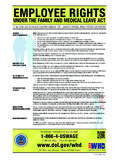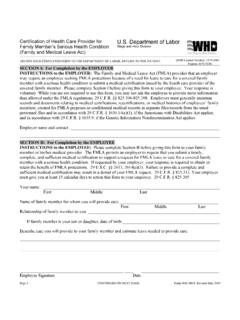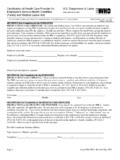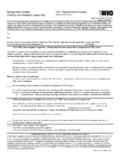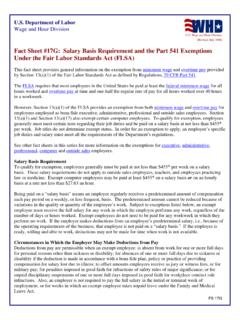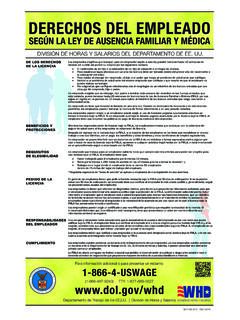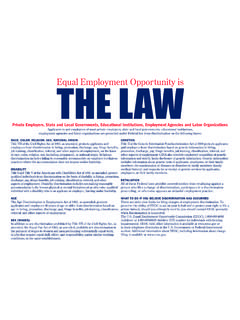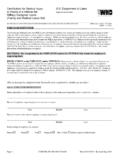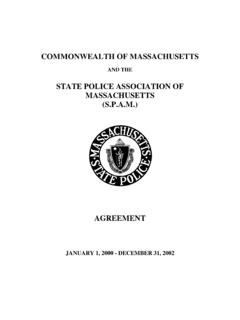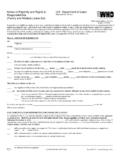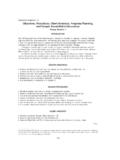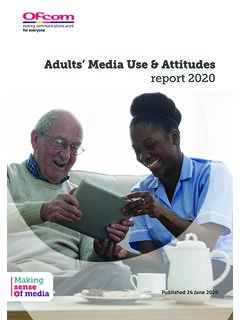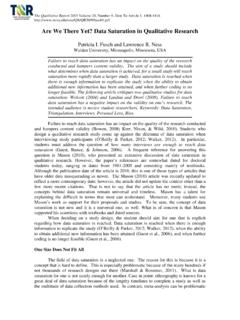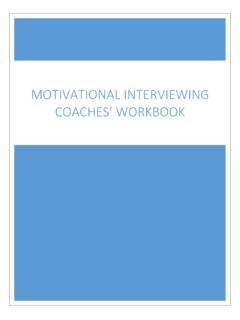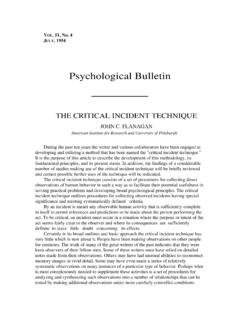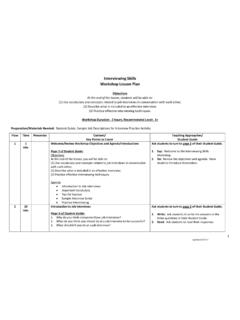Transcription of Employment Fundamentals of Career Transition (EFCT)
1 Department of Labor Employment Fundamentals of Career Transition (EFCT) Participant Guide January 2021 Edition Employment Fundamentals of Career Transition Participant Guide Employment Fundamentals of Career Transition Participant Guide 2 Table of Content Section 1 Getting Started .. 5 Objectives .. 5 Course Overview .. 6 Prerequisites .. 7 Career Transition Timeline .. 8 Activity: Where Are You Now? .. 9 Section 2 Planning Your Next Steps .. 11 Factors to Consider When Selecting a Career .. 11 Labor Market Research .. 13 Activity: Use Labor Market Research to Research Occupations & Identify Requirements.
2 15 Activity: Identify the Occupation Outlook & Salary Range .. 17 Activity: Final Analysis .. 19 Additional Transition Workshops .. 20 Getting Help at the American Job Center (AJC) .. 21 Activity: Access the AJC Online .. 22 Section 3 Preparing for Success .. 24 Think Like an Employer .. 26 Adjustment to the Workplace .. 26 Translating Military Terminology into Civilian Terms .. 29 Employment History Outline .. 31 Activity: Create Your Employment History Outline .. 31 Resumes .. 32 Create a Resume that Stands Out with the STAR Method.
3 35 What is the STAR Method? .. 35 Putting STAR into Practice .. 35 Activity: Creating an Achievement Statement using the STAR Method .. 37 Professional Introduction .. 38 Activity: Draft Your Professional Introduction .. 39 Networking .. 42 Activity: Identify Your Network Contacts .. 42 Expanding Your Network to Online Networking .. 44 Employment Fundamentals of Career Transition Participant Guide Employment Fundamentals of Career Transition Participant Guide 3 Using LinkedIn .. 45 Effective LinkedIn Profiles .. 45 Getting Started and Profile Photo.
4 45 Activity: Create Your Headline .. 46 Activity: Draft Your Summary Statement .. 46 Section 4 Applying for a Job .. 52 How Hiring Occurs .. 52 Selecting an Application Method .. 53 Seeking Out Veteran Ready Employers .. 54 Activity: Job Search .. 54 Analyze a Job Posting .. 57 Activity: Analyze a Job Posting for Keywords & Information .. 58 Completing a Job Application .. 60 After the Application Process .. 61 Section 5 Interviewing for a Job .. 63 Stages of an Interview .. 63 Types of Interview Questions .. 64 STAR Method for Interview Questions.
5 67 Section 6 Receiving a Job Offer .. 69 Evaluating a Job Offer .. 69 Section 7 Communicating Your Decision .. 71 Negotiating Job Offers .. 72 How to Negotiate .. 73 Negotiation Outcome .. 74 Section 8 Summing It Up .. 76 Section 9 Appendix .. 78 Practice Answering Interview Questions .. 78 Example Chronological Resume .. 79 Example Combination Resume .. 80 Website Guide .. 81 Employment Fundamentals of Career Transition Participant Guide Employment Fundamentals of Career Transition Participant Guide 4 Getting Started 1 Employment Fundamentals of Career Transition Participant Guide Employment Fundamentals of Career Transition Participant Guide 5 Section 1 Getting Started Thank you for your service, and congratulations on embarking on the next phase of your Career !
6 The purpose of this course is to provide you with the essential tools and resources you need to evaluate Career options, gain information for Employment , and understand the Fundamentals of the Employment process. Objectives Upon completion of this training, you will have learned how to: Conduct occupational research and job search for selected careers. Complete the Labor Market Information Analysis. Understand the civilian work environment. Use the STAR method to write achievement statements. Recognize the basic sections of a resume. Draft an Employment history outline.
7 Draft a professional introduction to use for networking. Identify your network contacts. Draft a headline and summary for your LinkedIn profile. Analyze a job vacancy posting. Connect your skills and abilities with the needs of an employer. Identify the relevant factors in evaluating a job offer. Employment Fundamentals of Career Transition Participant Guide Employment Fundamentals of Career Transition Participant Guide 6 Course Overview In this training, we will discuss the Fundamentals of the Employment process, which is explained in the six stages below.
8 The table below shows a breakdown of each stage, including the focus, topics, and activities that we will cover in each lesson. Employment Process Stage Stage Focus Topics & Activities 1. Plan your next steps. What do you want to do next? Factors to consider when selecting a Career Labor market research Activity: Career research Additional workshops Activity: Getting help at your American Job Center 2. Prepare for success. What documents and items do you need to prepare for the Employment process? Adjusting to the civilian workplace Translating military terminology into civilian terms Employment history outline Activity: Start your Employment history outline Basics of a resume Activity: Write a STAR achievement statement Professional introduction Activity: Draft your professional introduction Networking Activity: Identify your network contacts Online networking Activity.
9 Create a LinkedIn profile and draft your headline and summary statement Employment Fundamentals of Career Transition Participant Guide Employment Fundamentals of Career Transition Participant Guide 7 Employment Process Stage Stage Focus Topics & Activities 3. Apply for a job. How do you make your application stand out from the crowd? How hiring occurs Selecting an application method Seeking out Veteran-Ready employers Activity: Search for a job Analyzing a job posting Activity: Analyze job posting for keywords and information Tips for completing an Employment application Follow up on job application 4.
10 Interview for a job. How will you demonstrate your value to an employer? Stages of an interview Types of questions 5. Receive a job offer. What do you need to do after you get the job offer? Know the terms of an offer Activity: Evaluate the job offer 6. Communicate your decision. How do you inform the employer of your decision? Informing employer of your decision Negotiating job offers Prerequisites The Transition Assistance Program (TAP) curriculum is an outcome-based, modular curriculum with standardized learning objectives.
